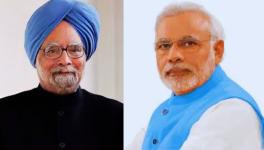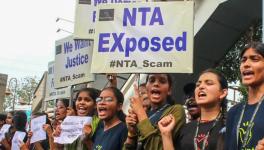Union Budget 2012-13: An Exercise in Neo-liberal Policy-making
The Union Budget was placed by the Finance Minister in the Parliament on Friday 16th March 2012. Right in the beginning of his speech he mentioned that there has been a growth slowdown in the economy, the rate of inflation remained high and the fiscal deficit overshot the target. Given this situation of the economy, it was hoped that the budget will address these problems. The article tries to analyze how far the Finance Minister has been successful in providing solutions to these problems.
Some Stylized Facts
The Indian economy, according to the admission of the government itself has slowed down. In the year 2011-12, the growth rate of GDP was 6.9% down from 8.4% in the previous year. If we look at the sectoral composition of GDP, we will find that manufacturing growth rate has slowed down to 3.9% from 7.6% in the previous year, while the mining growth rate has turned negative. One of the most important reason for the slowing down of the growth rate of the economy is the fact that investment has slowed down. Investment grew by only 5.6% in 2011-12, slowing down from 7.5% in the previous year. This slowdown in investment has resulted in a decline in the investment-GDP ratio from 36.6% in 2010-11 to 35.1% in the current year. If we look deeper into the investment data we will find that the investment by both the public as well as the private sector has slowed down. But within the private sector, the share of corporate investment in GDP has declined from 12.7% to 12.1% while that of the household investment has increased from 12.4% to 12.8%. The share of public investment in GDP decreased from 9.2% in 2010-11 to 8.8% in 2011-12. In other words, the decline in the share of investment in GDP is a result of a decline in both the public and the corporate sector investment.
On the other hand, if we look at the price situation, a mixed picture emerges. If we take the WPI inflation rate, it is seen that in the year 2010-11, the average inflation rate was 9.56%. In the year 2011-12, the inflation rate was 10% in September 2011 and subsequently declined to 7% in February 2012 with food price inflation shooting up to 6.1% from a negative figure in January 2012. In this situation, the Reserve Bank of India maintains that there still exists an upside risk to inflation, because of which it did not change the lending rates in its Mid-quarter Monetary Policy Review on 15th March 2012. In the last year's budget, it was projected that the fiscal deficit would be 4.6% for the year 2011-12 but it has shot up to 5.9%.
Since the union budget is essentially an accounting exercise of the government, let us first look at the revenue and expenditure of the government in details. The first issue that is raised repeatedly in this regard is that the fiscal deficit must be reduced. At the outset it must be mentioned that there exists no sound economic reason to believe that a high fiscal deficit crowds out private investment. This view of crowding-out was first proposed in 1929 by the British Treasury, in the midst of the Great Depression, when Lloyd George proposed that public investment should be stepped up for reducing unemployment. The entire Kenyesian revolution in economics rubbished this Treasury view of crowding-out. However, the hegemony of global finance has entailed a revival of this view in economic policy-making all over the world. Theoretically, however, there exists no reason why an increase in fiscal deficit should crowd-out private investment.
The fiscal deficit essentially is the difference between the expenditure of the government and its revenue, which consists mainly of taxes. In the last year, the government failed to attain its own targets of tax collection from the corporates and the rich. The target for corporate tax collection was set at Rs359990 crore, but only Rs 327680 crore could be collected, leading to a short-fall of more than Rs32000 crore. If we look at personal income tax collection, then the short-fall from the target set in the last budget is Rs 147 crore. In other words, around Rs32100 crore of direct taxes could not be collected by the government. On the other hand, in terms of indirect tax collection, the total collection was Rs 888 crore above what was projected in the last budget. Therefore, on the whole, the total tax collection fell short by more than Rs 31000 crore from the target set last year. Also, the non-tax revenue fell short from the target by Rs 698 crore. All this resulted in a total revenue short-fall of Rs 22903 crore from the target announced last year. Additionally, Rs 93612 crore of tax concessions were given to the corporates and the rich, of which Rs 51292 crore were given to the corporates. If we consider all this, then it is obvious that the short-fall in revenue collection is much less than the total amount of tax concessions that have been provided. If only 25% of the tax concessions were not given and instead collected, there would have been no short-fall from the targeted revenue collection.
If we look at the expenditure side, it is seen that the major increase from the targeted expenditure in last budget has been in terms of an increase of Rs 74292 crore in subsidies. This overshooting of the subsidies is again a result of mainly an increase in petroleum subsidy worth around Rs 45000 crore. This overshooting from the target in the petroleum subsidy is again a result of an increase in crude oil prices in the international market. However, even then it must be noted that the tax concessions provided to the corporates and income tax payers can cover the entire increase in the petroleum subsidy.
Given that the fiscal deficit has crossed the budget estimates for last year, from the very beginning the emphasis was on reducing the deficit. Now, as we have already argued that there exists no solid theoretical grounds for reducing the fiscal deficit, more so at a time when the public debt-GDP ratio in India has come down from 51.2% in 2010-11 to 45.7% in 2011-12. However, the obsession with reducing the fiscal deficit has resulted in some bizarre policy announcements by the Finance Minister.
Firstly, how does one reduce the fiscal deficit? It can be done in two alternative ways, either by increasing tax collection or by reducing the expenditure. In terms of tax collection, given that there was a significant short-fall in direct tax collection, the logical thing to do would have been to try and increase the direct tax collection. However, what the Finance Minister has decided is to give tax concessions to the salaried people and do nothing about increasing tax collection from the corporate sector. By his own admission, the tax concessions given to the salaried persons would result in a revenue loss of Rs 4500 crore. In order to increase tax collection, what the Finance Minister has relied on is an increase in indirect taxes, which is estimated to generate an extra revenue of Rs 45940 crore. It is elementary economics that revenue mobilization primarily through indirect tax rather than direct tax is regressive. On the other hand, with increase in indirect taxes, inflationary pressures are generated in the economy. Given that the Reserve Bank of India has already warned about an upward risk on inflation, such reliance on indirect taxes for revenue mobilization puts into serious doubt the seriousness of the government about reducing inflation. It must however be noted that many of the items whose excise duties have been increased are luxury items which is welcome. But the reduction in Securities Transaction Tax only shows that the government is more interested in protecting the interests of finance capital than the common people. Again, Rs 30000 crore has been announced as the target of fund mobilization from disinvestment of public sector units in the next fiscal year.
With respect to expenditure, there has been a severe cut-back on subsidies. This cut in subsidies is targeted to be achieved by mainly reducing the subsidy on petroleum products by Rs 25000 crore. This essentially presages a de-regulation of other petroleum product prices. Otherwise, with the increase in the price of crude oil in the global market and increasing demand for oil from India, there is no way that the subsidy can be reduced. In other words, we may be moving towards such a scenario of deregulated diesel or LPG prices in the near future. This would again raise prices and therefore have an adverse impact upon the inflationary situation in the country. At the same time, the government has made its intentions very clear that it would rely more and more on cash transfer schemes for providing targeted subsidies, relying on the data generated by the Adhaar project. Such targeting of subsidies will result in huge exclusion error and thereby be taken away from the poor. In other words therefore, the revenue and expenditure proposed in this budget is essentially pro-rich and anti-poor.
The issue of the expenditure of the government does not end here. As we have already pointed out, there has been a slowdown in the economy. If this slowdown has to be reversed, there has to be an increase in investment in the country, which has also come down in the last year. The issue therefore boils down to how an increase in investment can be ensured. Again, there are two ways by which this investment can be raised. Firstly by an increase in public investment and secondly by private investment. We have already pointed out that both these investments have slowed down in the last year. So, what does the government do about it? In his speech the Finance Minister gives a long list of the steps that he wants to take to increase investment in the economy. All these steps are essentially in terms of giving signals to the private corporate sector that their interests will be protected by the government. This is not very surprising because the current growth process in the Indian economy is essentially one led by the corporate sector, (within a world dominated by finance capital). To stimulate this growth again, the government has to continually woo this sector for undertaking investment in the economy. This takes the form of providing the corporate sector with massive tax concessions. As noted earlier Rs 51292 crore was provided as tax concessions to the corporate sector only. Secondly, it is not only enough that these tax concessions are provided to the corporates. Additionally, the government has to show with acts and deeds that they are ready to hand over public assets to the private sector for ensuring ‘investor confidence’. A target of Rs 30000 crore has been set for disinvestment of public sector companies in this year's budget.
Moreover, in order to woo finance capital continuously policies have to be devised which satisfies their profit earning motive. In this budget what the Finance Minister has essentially done is to try and woo finance to invest in India. This explains the policy announcements with respect to External Commercial Borrowing in various sectors, the commitment that the bank, finance, insurance sectors will be liberalized in this session of Parliament, reduction of STT, opening up the company bond market to Foreign Institutional Investors etc.
This reliance on finance capital and the corporate sector to ensure growth in the economy is fundamentally misplaced for a number of reasons. Firstly, this sort of growth is highly inequalizing as has been the case in India. Secondly, this form of growth does not generate any increase in employment. The latest round of NSS sample survey makes it amply clear that employment has not increased between 2004-05 and 2009-10. Thirdly, there also exists a contradiction between following such a growth trajectory and democracy in the country. This is because with the government relying totally on the corporates for growth, the corporates and finance capital increasingly become more demanding. But as these policies of reforms do not benefit the common people at all, they protest. For example, many policies of the present government have been withheld because of the opposition by various parties and people. This democratic opposition to these policies are antithetical to the working of finance capital. The current Economic Survey says, “There were also the pressures of democratic politics, which slowed reforms”. This only shows how much the government has become subservient to finance capital, where in its official document the government is blaming democracy for stalling the reform process instead of asking the question as to whether such reforms serve the interests of the people or not. In other words, the growth process led by the corporates and finance capital will essentially increase the economic and political instability in the country, where the gap between the haves and the have nots will increase further and further.
What was required of the government in this situation is to increase its own investment drastically to ensure robust growth. The public investment driven growth process in terms of infrastructure building, investment in human capital, investment in public sector undertakings are both inequality reducing and employment intensive. The latest budget presented by the government was an opportunity to go for such a growth trajectory. But far from being that, essentially the government has decided to maintain a status quo as far as its economic role is concerned. This is evident from the fact that the expenditure-GDP ratio has not been increased at all—it was 14.6% in 2011-12 and is projected to remain so in the next fiscal. On the face of a downturn in the economy, the fact that government expenditure ratio, which can significantly augment demand and increase growth rate, did not rise only shows that for the government only a corporate driven growth trajectory is possible.
However, it is precisely this growth trajectory that has resulted in decline in employment, increase in inequality, increase in inflation etc. With its commitment towards following a corporate-led neo-liberal growth model, the government is ensuring that the miseries of the people will continue. Governments around the world, particularly in the advanced capitalist countries, in the aftermath of the global financial crisis, has learnt the lesson that relying on corporates and finance capital to augment growth in the economy does not pay off, since the entire system becomes crisis-prone. The Indian government it seems has not learnt this lesson.
Get the latest reports & analysis with people's perspective on Protests, movements & deep analytical videos, discussions of the current affairs in your Telegram app. Subscribe to NewsClick's Telegram channel & get Real-Time updates on stories, as they get published on our website.
























